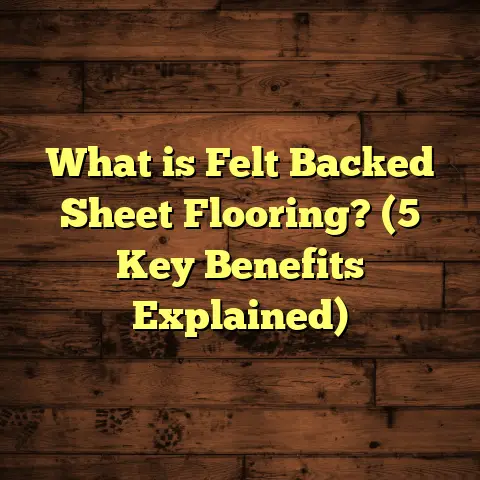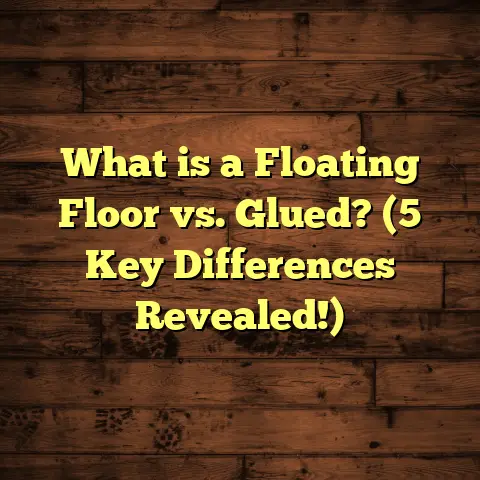What is Concrete Slab Flooring? (5 Key Benefits You Must Know)
There’s a popular belief that concrete floors are cold, dull, and only suitable for industrial spaces or unfinished basements. I’ve heard this from many people over the years, especially those considering flooring options for their homes. They often shy away from concrete slab flooring because they think it’s just plain gray and uncomfortable. But having worked with concrete slab floors for years, I can confidently say that this myth misses the mark completely. Concrete slab flooring is one of the most versatile, durable, and cost-effective flooring choices out there—once you get to know it better.
If you’re curious about what concrete slab flooring really is and why it might be a great fit for your next project, stick around. I’ll walk you through everything from the basics to some insider tips and experiences I’ve gathered on the job.
What Is Concrete Slab Flooring?
Concrete slab flooring is essentially a large, flat surface made of concrete that forms part of a building’s foundation or acts as the finished floor itself. Unlike other flooring materials—like hardwood, tile, or carpet—concrete slabs serve both as structural support and a walking surface. This dual role makes them unique in the world of flooring.
Concrete is a composite material composed of cement (usually Portland cement), water, sand, and aggregates such as gravel or crushed stone. When mixed and poured onto a prepared base, it hardens into a solid mass capable of bearing significant weight.
The Basics of Concrete Slabs
Typically, concrete slabs are poured directly on top of compacted soil or a gravel base. The thickness varies depending on the application:
- Residential floors: Usually 4 to 6 inches thick.
- Garage floors: Generally 5 to 6 inches thick due to heavier load requirements.
- Commercial or industrial floors: 6 to 12 inches or more, sometimes reinforced with steel beams or thicker reinforcement.
To prevent cracking and increase strength, slabs are reinforced with steel rebar or welded wire mesh embedded inside the concrete before it cures.
The Manufacturing and Installation Process
Let me break down the typical steps involved in creating a concrete slab floor:
1. Site Preparation:
Before pouring concrete, the area must be excavated and leveled. A stable subgrade (soil base) is essential to prevent future settling or cracks. Sometimes a gravel layer is added for drainage and stability.
2. Formwork Construction:
Wooden or metal forms are built around the perimeter to hold the wet concrete in place. These forms dictate the final shape and thickness of the slab.
3. Reinforcement Placement:
Steel rebar or wire mesh is laid inside the forms to strengthen the slab against tensile forces. This reinforcement helps control cracking caused by shrinkage or external loads.
4. Mixing and Pouring:
Concrete is mixed either onsite or delivered ready-mixed by a truck. The wet concrete is poured evenly into the forms.
5. Leveling and Screeding:
The concrete surface is leveled with a screed board (a long straight edge) to remove excess material and create a flat surface.
6. Floating and Troweling:
Once initial leveling is done, tools like floats and trowels smooth the surface further. This step determines how smooth or textured the final finish will be.
7. Curing:
Curing is vital. The slab must stay moist for at least 7 days (up to 28 days for full strength) to allow proper hydration of cement particles. This can be done by covering with plastic sheets, applying curing compounds, or regularly sprinkling water.
8. Finishing Touches:
Depending on the intended use, the slab might be sealed, stained, polished, stamped (textured), or covered with additional materials like epoxy coatings.
Technical Specs That Matter
Here are some numbers you might find useful:
- Compressive strength: Residential slabs typically have 3,000 to 4,000 psi (pounds per square inch). Commercial slabs can reach 6,000 psi or higher.
- Thickness: 4–6 inches for homes; garages often require at least 5 inches.
- Reinforcement spacing: Rebar is usually placed on 12-inch centers in both directions.
- Water-cement ratio: Lower ratios (around 0.40 to 0.50) lead to stronger concrete but can be harder to work with.
- Curing time: Minimum 7 days moist curing; full strength after about 28 days.
Why Did I Start Using Concrete Slab Floors So Often?
When I began my career in flooring installation, I mostly worked with traditional options: hardwood, laminate, vinyl, and tiles. My early projects involved patching up floors with some damage or helping clients choose something warm and comfortable.
But then I got involved with a commercial renovation project where the client wanted a clean, modern look but also needed exceptional durability for heavy equipment and foot traffic. The existing wooden floors had rotted and warped over time. We decided to pour a new concrete slab floor instead of replacing it with more wood or tile.
I was skeptical at first—would clients like it? Would it feel too cold? Would it be slippery?
The surprising answer was no—once polished and sealed properly, the floor looked sleek and felt surprisingly comfortable underfoot. Plus, maintenance was a breeze compared to wood or carpet.
Since then, I’ve embraced concrete slabs in many projects—from modern homes to retail stores—even outdoor patios where durability against weather is critical.
5 Key Benefits of Concrete Slab Flooring You Must Know
1. Durability That Outlasts Other Flooring Types
Concrete slabs are among the toughest floors you can install. Unlike wood, which can warp or rot with moisture exposure, or carpet that stains easily and traps allergens, concrete stands up to just about anything.
I recall a warehouse project where forklifts rolled back and forth on polished concrete floors daily for over a decade—with virtually no signs of wear. The compressive strength of concrete means it resists cracking under heavy loads if installed correctly.
Because of this durability:
- Residential slabs can last over 50 years.
- Commercial and industrial slabs often last 75 years or more with minimal repairs.
- Maintenance primarily involves cleaning rather than replacement.
Data point: According to the Portland Cement Association (PCA), well-maintained concrete floors outperform most alternative materials in lifespan by decades.
2. Energy Efficiency Thanks to Thermal Mass
Ever notice how some buildings stay cooler during hot days without air conditioning? Concrete’s thermal mass plays a big role in that.
Thermal mass means concrete absorbs heat during warm parts of the day and releases it slowly when temperatures drop—helping stabilize indoor climates naturally.
In one home I worked on last year, installing radiant heating beneath a concrete slab cut heating costs by nearly 20% compared to traditional forced-air systems paired with carpeted floors.
How Does Radiant Heating Work?
Radiant heating systems pump warm water through tubing embedded beneath the slab’s surface. The concrete then radiates heat upward evenly across the floor—making your toes happy on cold mornings!
This system works best with concrete because:
- The slab holds heat longer.
- Heat disperses evenly rather than concentrating in spots.
- It reduces dust circulation compared to forced air.
3. Low Maintenance Needs—Just Clean and Seal
Concrete floors don’t require fancy products or special treatments to stay looking good.
Sweeping regularly and mopping with mild soap is usually enough to keep dirt at bay. A sealed slab resists:
- Stains from oil, wine, or food.
- Scratches from furniture or pets.
- Water damage that ruins wood floors.
I once had a client spill red wine during a party; because their slab was sealed with epoxy coating, the stain wiped off like magic—no scrubbing needed!
If small cracks appear over time (and they might), patching them is generally simple thanks to specialized repair compounds available today.
4. Design Flexibility That Surprises Many People
Concrete is not just gray and boring! It’s one of the most customizable flooring options out there.
Here are some ways I’ve used concrete creatively:
- Staining: Acid-based stains react chemically with concrete producing translucent earthy tones like browns, reds, greens.
- Polishing: Grinding multiple times with finer diamond pads results in a shiny surface resembling polished stone.
- Stamping patterns: Freshly poured slabs can be pressed with mats creating textures mimicking brick, tile, cobblestone.
- Overlaying: Thin cementitious overlays allow adding texture or color on existing slabs without removing them.
- Dyeing: Concrete dyes produce vibrant colors unavailable through stains alone.
One project involved turning an old warehouse floor into an art gallery by staining sections in deep blue and gray geometric patterns—an instant hit!
5. Cost-Effectiveness Over Long-Term Use
While initial installation costs can vary depending on finish and thickness, concrete slab flooring often becomes more economical over time when you factor in durability and maintenance savings.
Here’s how I break down costs in my own projects:
- Basic poured slab: $3 to $5 per square foot.
- Polished finishing: $5 to $10 per square foot depending on polishing level.
- Stained finishes: $4 to $8 per square foot.
- Radiant heating embedded: Additional $5 to $10 per square foot.
For comparison:
- Hardwood installation runs $8–$15 per square foot upfront plus refinishing every few years.
- Tile costs $5–$12 per square foot but grout cleaning can add upkeep costs.
- Carpet may be cheaper initially but needs replacement every 7–10 years.
To help clients understand these numbers better, I often use FloorTally—a handy online tool that lets me enter specifics like slab thickness, finish type, local labor rates, and waste factor for precise estimates. It saves me time crunching numbers manually and helps clients set realistic budgets without surprises later.
More Technical Details: Reinforcement & Concrete Mix Designs
Reinforcement is critical in preventing cracks and extending slab life.
Steel Rebar vs Wire Mesh
- Wire Mesh: Made from welded steel wires spaced at regular intervals; common in residential slabs for light loads.
- Rebar: Solid steel rods that provide higher tensile strength; necessary for garages or commercial floors subjected to heavy vehicles/equipment.
During installation, rebar sits approximately mid-thickness of the slab supported by plastic chairs or wire supports to maintain position while pouring.
Concrete Mix Considerations
The mix design affects strength, workability, durability:
- Water-cement ratio should be as low as possible without compromising workability (usually between 0.40–0.50).
- Admixtures like plasticizers improve flow without adding water.
- Fly ash or slag cement additions improve durability by reducing permeability.
- Air entrainment improves resistance against freeze-thaw cycles in colder climates.
Controlling Cracks
Cracking often occurs due to shrinkage during curing or temperature changes:
- Control joints are saw-cut lines at regular intervals (every 8–12 feet).
- Fiber reinforcement mixed into concrete reduces micro-cracking.
- Proper curing methods prevent rapid drying shrinkage cracks.
A Closer Look Through Case Studies
Case Study 1: From Drab Basement to Cozy Living Space
A homeowner approached me wanting to convert their damp unfinished basement into a livable family room space without risking mold issues common under carpet or wood floors in basements.
We opted for a polished concrete slab floor sealed with moisture-resistant epoxy coating combined with radiant heating beneath for comfort.
Outcome:
- Moisture-proof surface prevented mold growth.
- Warm floors improved comfort dramatically.
- Low maintenance suited busy family life.
The client was thrilled with how modern yet practical their new basement looked—and how affordable it was compared to hardwood alternatives.
Case Study 2: Retail Store With Heavy Foot Traffic
A local retailer needed a durable floor that could withstand thousands of customers weekly plus heavy shelving units moved around regularly.
We chose a 6-inch thick reinforced concrete slab polished for aesthetics but tough enough for daily abuse.
Outcome:
- No visible wear after two years despite heavy use.
- Easy cleanup during busy hours using simple sweeping/mopping.
- Positive customer feedback on sleek appearance enhancing store ambiance.
What About Installation Challenges?
Though concrete slabs are fantastic when done right, they come with their own set of challenges:
Timing Is Everything
Concrete must be poured quickly after mixing before it begins setting—this means coordinating delivery trucks precisely on site.
Weather Conditions Affect Quality
Extreme heat can cause rapid drying leading to cracking; cold weather slows curing which delays strength gain. I’ve learned from experience that preparing protective covers or heaters for slabs in extreme weather helps maintain quality.
Subgrade Preparation Is Critical
A poorly prepared base leads to settling cracks or uneven surfaces later on. Compacting soil properly before pouring is non-negotiable; I always insist on soil testing before starting any slab work.
How I Use Technology Like FloorTally To Make Projects Smoother
Estimating costs for flooring projects can get complicated fast—especially when comparing materials like hardwood vs tile vs concrete slabs with different finishes.
FloorTally helps me input variables such as:
- Square footage
- Material types
- Labor rates based on location
- Waste factor percentage
- Finishing options (polished, stained)
It spits out detailed cost breakdowns instantly which I use when talking budgets with clients. It also helps me tweak options in real time—like changing finish type—to show how costs shift accordingly.
This tool has saved me hours on manual calculations and made my proposals more accurate—which clients appreciate because they avoid nasty surprises mid-project.
Caring For Your Concrete Slab Floor: Tips From My Experience
Even though concrete floors are low maintenance, here are some things I recommend based on years of fixing avoidable problems:
- Seal Early: Applying sealants within weeks after curing protects against stains and moisture damage.
- Use Rugs in High-Traffic Areas: Entryways benefit from rugs to catch dirt/grit that might scratch surfaces over time.
- Avoid Harsh Chemicals: Stick with pH-neutral cleaners instead of bleach or ammonia that degrade sealers.
- Prompt Spill Cleanup: Especially acidic substances like vinegar or wine can etch unsealed surfaces if left too long.
- Reseal Every Few Years: Even high-quality sealers wear down gradually; recoating ensures lasting protection.
- Fix Cracks Early: Small hairline cracks can be filled easily before they widen or cause structural issues.
Wrapping Up My Thoughts On Concrete Slab Flooring
Honestly? Concrete slab flooring has been one of the most rewarding materials I’ve worked with—not just because it’s tough but because it offers so many possibilities for design and functionality that people rarely expect at first glance.
Whether you’re building new foundations or renovating existing spaces, giving this option serious thought could save you time, money, and headaches down the line while delivering stunning results that last decades.
I hope this gives you a clearer picture of what concrete slab flooring really means beyond the myths—and maybe even inspires you to consider it for your next project!
If you want more personalized advice based on your space or budget constraints—or if you want me to help crunch numbers using FloorTally—I’m here anytime!
Would you like me to include detailed comparisons between concrete finishes? Or maybe share more about radiant heating systems integrated within slabs? Just let me know!





